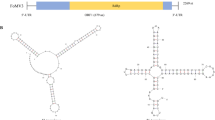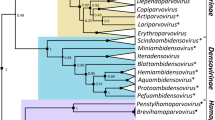Abstract
Bermuda grass samples were examined by transmission electron microscopy and 28-30 nm spherical virus particles were observed. Total RNA from these plants was subjected to high-throughput sequencing (HTS). The nearly full genome sequence of a panicovirus was identified from one HTS scaffold. Sanger sequencing was used to confirm the HTS results and complete the genome sequence of 4404 nt. This virus was provisionally named Bermuda grass latent virus (BGLV). Its predicted open reading frames follow the typical arrangement of the genus Panicovirus. Based on sequence comparisons and phylogenetic analyses BGLV differs from other viruses and therefore taxonomically it is a new member of the genus Panicovirus, family Tombusviridae.


Similar content being viewed by others
References:
Ahlawat Y, Pant R, Lockhart B et al (1996) Association of a badnavirus with citrus mosaic disease in India. Plant Dis 80:590–592
Yamamura Y, Scholthof HB (2005) Tomato bushy stunt virus: a resilient model system to study virus-plant interactions. Mol Plant Pathol 6:491–502
Al Rwahnih M, Daubert S, Golino D, Rowhani A (2009) Deep sequencing analysis of RNAs from a grapevine showing Syrah decline symptoms reveals a multiple virus infection that includes a novel virus. Virology 387:395–401
Al Rwahnih M, Daubert S, Golino D et al (2015) Comparison of next-generation sequencing versus biological indexing for the optimal detection of viral pathogens in Grapevine. Phytopathology 105:758–763
Wang Z, Gerstein M, Snyder M (2009) RNA-Seq: a revolutionary tool for transcriptomics. Nat Rev Genet 10:57–63
Boonham N, Kreuze J, Winter S et al (2014) Methods in virus diagnostics: from ELISA to next generation sequencing. Virus Res 186:20–31
Barba M, Czosnek H, Hadidi A (2014) Historical perspective, development and applications of next-generation sequencing in plant virology. Viruses 6:106–136
Mollov D, Lockhart B, Zlesak DC (2013) Complete nucleotide sequence of Rosa rugosa leaf distortion virus, a new member of the family Tombusviridae. Arch Virol 158:2617–2620
Tamura K, Stecher G, Peterson D et al (2013) MEGA6: molecular evolutionary genetics analysis version 6.0. Mol Biol Evol 30:2725–2729
Castano A, Ruiz L, Hernandez C (2009) Insights into the translational regulation of biologically active open reading frames of Pelargonium line pattern virus. Virology 386:417–426
Scheets K, Blinkova O, Melcher U et al (2011) Detection of members of the Tombusviridae in the Tallgrass Prairie Preserve, Osage County, Oklahoma, USA. Virus Res 160:256–263
Scheets K (2013) Infectious transcripts of an asymptomatic panicovirus identified from a metagenomic survey. Virus Res 176:161–168
Sabath N, Wagner A, Karlin D (2012) Evolution of viral proteins originated de novo by overprinting. Mol Biol Evol 29:3767–3780
Turina M, Desvoyes B, Scholthof KB (2000) A gene cluster encoded by panicum mosaic virus is associated with virus movement. Virology 266:120–128
Author information
Authors and Affiliations
Corresponding author
Ethics declarations
All authors declare they have no conflict of interest. The research reported in this manuscript did not involve experimentation with humans or animals. Plant samples were moved within USA under USDA APHIS permit P526P-13-03719.
Electronic supplementary material
Below is the link to the electronic supplementary material.
Rights and permissions
About this article
Cite this article
Tahir, M.N., Lockhart, B., Grinstead, S. et al. Characterization and complete genome sequence of a panicovirus from Bermuda grass by high-throughput sequencing. Arch Virol 162, 1099–1102 (2017). https://doi.org/10.1007/s00705-016-3165-4
Received:
Accepted:
Published:
Issue Date:
DOI: https://doi.org/10.1007/s00705-016-3165-4




